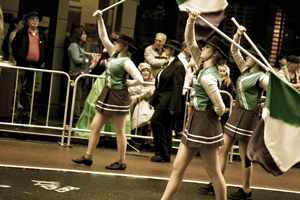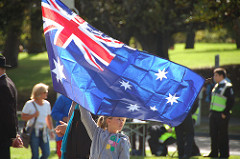Dance ES1
Overview

Hunter School of the Performing Arts Marching Band, Anzac Day Sydney, 2014
©Department of Education (HSPA)
Students explore Anzac Day movements. They use a marching movement as a returning motif while exploring other movements to create a sequence of movements to create a composition.
Teaching and learning activities

Anzac Day parade, Melbourne, 2013
How do people move on Anzac Day?
-
Consider how people move on Anzac Day. Think about different parts of the body. Some people march and some wave.
-
View video footage of Anzac Day marches.
-
Look at how people move at the Anzac Day ceremony. Does everyone move together?
-
Direct students to march as a group and then one or two students to improvise and move freely at a certain time and then return to moving with the group.
-
Use a marching movement as a returning motif while exploring other movements to create a sequence of movements to create a composition.
-
Develop movements with the musical soundscape as accompaniment.
Resources (YouTube clips):
Hunter School of the Performing Arts dancing and marching at Anzac Day Parade 2012 Sydney HD – (Pt17)
Learning concepts
These additional questions can be used for discussion or further investigations.
Community
How does the community interact in an Anzac Day march?
Commemoration
Why is marching a component of Anzac Day commemorations?
What actions do spectators do at Anzac March to acknowledge and congratulate the people in the parade?
Syllabus links
Students perform dances with some control over body movement and expression. They respond to a range of stimuli, drawing from experience and imagination, exploring the notion that dance is about moving the body to express ideas. Students watch dance performances and begin to recognise some basic components of dance.
DAES1.1 Participates in dance activities and demonstrates an awareness of body parts, control over movement and expressive qualities.
DAES1.2 Explores movement using the elements of dance in response to a stimulus to express ideas, feelings or moods.
DAES1.3 Responds to and communicates about the dances they view and/or experience.